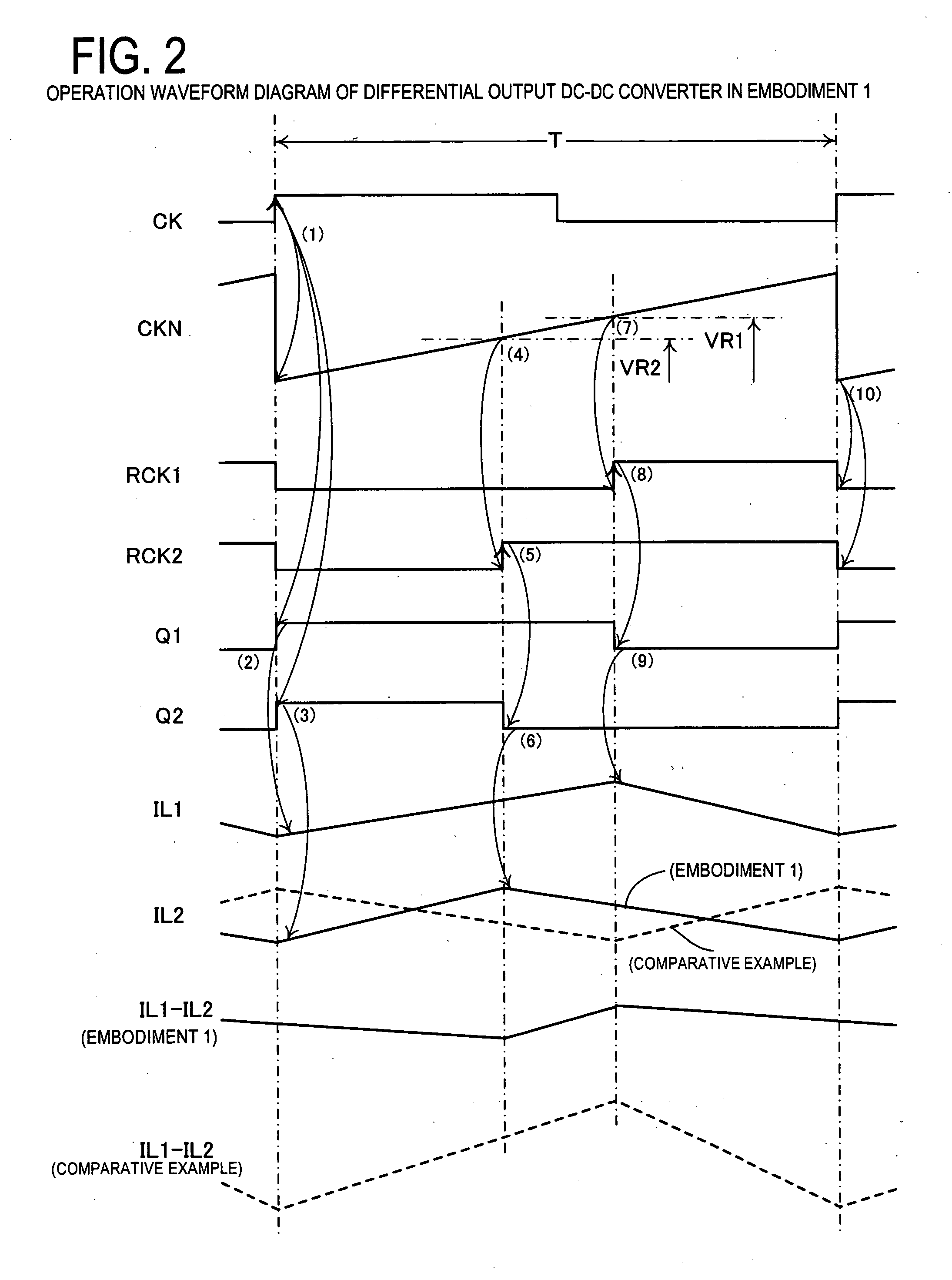DC-DC converter and its control method, and switching regulator and its control method
a technology of dc-dc converter and control method, applied in the direction of electric variable regulation, process and machine control, instruments, etc., can solve the problems of increasing power consumption and heat generation in the entire system, excessive power spent in the conversion of a voltage in both regulators, etc., and achieve the effect of preventing the inversion of the polarity of the error signal
- Summary
- Abstract
- Description
- Claims
- Application Information
AI Technical Summary
Benefits of technology
Problems solved by technology
Method used
Image
Examples
embodiment 1
[0024]FIG. 1 is a circuit diagram of a differential output DC-DC converter 1 in an embodiment 1 of the invention.
[0025] The differential output DC-DC converter 1 is a DC-DC converter for converting an input voltage V0 applied to a power supply terminal Vin into two sets of different output voltages V1 and V2, and issuing to output terminals VP and VM. The differential output DC-DC converter 1 comprises a first switching regulator 10 of a current source type, a second switching regulator 20 of a current sink type, and a control unit 30 for controlling the first switching regulator 10 and the second switching regulator 20.
[0026] The first switching regulator 10 includes a first transistor FET1 as a main switch, a second transistor FET2 as a synchronous rectifying circuit, a choke coil L1 as a main inductor, and a capacitor C1 as a smoothing capacitor. In the first transistor FET1 and the second transistor FET2, their source electrodes are connected to a power supply terminal Vin and...
embodiment 2
[0050]FIG. 3 is a circuit diagram of a differential output DC-DC converter 1A in an embodiment 2. The differential output DC-DC converter 1A operating in a current mode comprises a first switching regulator 10A of a current source type, a second switching regulator 20A of a current sink type, and a control unit 30A for controlling the first switching regulator 10A and the second switching regulator 20A.
[0051] The first switching regulator 10A is similar to a first switching regulator 10 of an embodiment 1, except that a sense resistance Rs1 is provided between a choke coil L1 and an output terminal VP. This sense resistance Rs1 converts a current IL1 flowing in the choke coil L1 into a voltage generated at both ends, and detects.
[0052] The second switching regulator 20A is similar to a second switching regulator 20 of an embodiment 1, except that a sense resistance Rs2 is provided between a choke coil L2 and an output terminal VM, and that a source electrode side of a fourth trans...
embodiment 3
[0055]FIG. 4 is a circuit diagram of a differential output DC-DC converter 1B in an embodiment 3. The differential output DC-DC converter 1B operating in a current mode comprises a first switching regulator 10B of a current source type, a second switching regulator 20B of a current sink type, and a control unit 30B for controlling the first switching regulator 10B and the second switching regulator 20B.
[0056] The first switching regulator 10B is similar to a first switching regulator 10 of an embodiment 1, except that a sense resistance Rs1 is provided between a choke coil L1 and an output terminal VM, and that a first diode D1 as an asynchronous rectifying circuit is provided instead of a second transistor FET2 as a synchronous rectifying circuit. This sense resistance Rs1 converts a current IL1 flowing in the choke coil L1 into a voltage generated at both ends, and detects.
[0057] The second switching regulator 20B is similar to a second switching regulator 20 of the embodiment 1...
PUM
 Login to View More
Login to View More Abstract
Description
Claims
Application Information
 Login to View More
Login to View More - R&D
- Intellectual Property
- Life Sciences
- Materials
- Tech Scout
- Unparalleled Data Quality
- Higher Quality Content
- 60% Fewer Hallucinations
Browse by: Latest US Patents, China's latest patents, Technical Efficacy Thesaurus, Application Domain, Technology Topic, Popular Technical Reports.
© 2025 PatSnap. All rights reserved.Legal|Privacy policy|Modern Slavery Act Transparency Statement|Sitemap|About US| Contact US: help@patsnap.com



